| |
 |
|
| Historical Perspectives: |
 ver four thousand years of chequered history have contributed immensely to the evolution of Indian textiles, besides bequeathing to the country a rich and pluralistic cultural legacy. These multicultural and ethnical influences have collectively and significantly altered and shaped Indian textiles as well. Fairs, festivals and different religious ceremonies inspired weavers and artisans to create special fabrics and textiles in India. An overview of Indian textiles from the Ancient Jaina times to the 20th century will help understand the cultural mosaic of India, with special focus on the prevalent cultures of the Northern, Eastern and Northeastern, Western and Central, and Southern India. India textile art has always been a means for explaining the philosophical essence and ethos of Indian culture. ver four thousand years of chequered history have contributed immensely to the evolution of Indian textiles, besides bequeathing to the country a rich and pluralistic cultural legacy. These multicultural and ethnical influences have collectively and significantly altered and shaped Indian textiles as well. Fairs, festivals and different religious ceremonies inspired weavers and artisans to create special fabrics and textiles in India. An overview of Indian textiles from the Ancient Jaina times to the 20th century will help understand the cultural mosaic of India, with special focus on the prevalent cultures of the Northern, Eastern and Northeastern, Western and Central, and Southern India. India textile art has always been a means for explaining the philosophical essence and ethos of Indian culture. |
|
 Demystified: Demystified: |
 ue to enormous pollution created by man-made activities, man itself is destroying its very essence from which it came i.e. earth. A seed sown in earth is nourished like a child. It then expresses itself into a magnanimous plant and blossoms into flowers; the fruits have its essence from its origin. Similarly ue to enormous pollution created by man-made activities, man itself is destroying its very essence from which it came i.e. earth. A seed sown in earth is nourished like a child. It then expresses itself into a magnanimous plant and blossoms into flowers; the fruits have its essence from its origin. Similarly  a brand of RTLL, has its true essence from earth. “Bhu” stands for earth and “sattva” stands for essence. a brand of RTLL, has its true essence from earth. “Bhu” stands for earth and “sattva” stands for essence.  is convergence of all the elements like traditional organic clothing with herbal dyes commingled with modern designer fashion wear to deliver the true essence of natural clothing. Like the joy of the river meeting the ocean at its bay is visible in its beautiful creation similarly the feel of wearing true essence is in itself inexpressible. The feel is sacred, the feel is consecrated, the feel represents wholeness with the essence. is convergence of all the elements like traditional organic clothing with herbal dyes commingled with modern designer fashion wear to deliver the true essence of natural clothing. Like the joy of the river meeting the ocean at its bay is visible in its beautiful creation similarly the feel of wearing true essence is in itself inexpressible. The feel is sacred, the feel is consecrated, the feel represents wholeness with the essence. |
|
| Rising Tradelink Limited – its core essence: |
 arth convergences all nourishing elements analogically RTLL’s arth convergences all nourishing elements analogically RTLL’s  convergences all elements of modern fashion along with traditional values combined with sustainable development of society and nature. Through the efforts of RTLL, convergences all elements of modern fashion along with traditional values combined with sustainable development of society and nature. Through the efforts of RTLL,  is a fine product of such conflux. RTLL itself was formed to address the growing need of organic foods providing best to its clients and thus so far has achieved its objective. To cater the need of organic garments, RTLL brought all possible genes of modern clothing in terms of finest designer, best organic fabrics from all across traditional land of India, purest natural herbal dyes for coloring and the best sustainable use of the natural resources of heritage India. is a fine product of such conflux. RTLL itself was formed to address the growing need of organic foods providing best to its clients and thus so far has achieved its objective. To cater the need of organic garments, RTLL brought all possible genes of modern clothing in terms of finest designer, best organic fabrics from all across traditional land of India, purest natural herbal dyes for coloring and the best sustainable use of the natural resources of heritage India.
Hence RTLL’s  causes to no pollution impact on environment, no health hazards for its craftsmen and technicians, unlike conventional clothing, and by and large helping India by empowering the craftsmen and technicians both economically and socially. causes to no pollution impact on environment, no health hazards for its craftsmen and technicians, unlike conventional clothing, and by and large helping India by empowering the craftsmen and technicians both economically and socially.  brand of clothing is specifically designed for international and domestic clients, keeping in view the trends of fashion integrated with traditional values. Through brand of clothing is specifically designed for international and domestic clients, keeping in view the trends of fashion integrated with traditional values. Through  RTLL strives to satisfying the needs of its prospective clients in terms of organic/herbal designer, tailor-made prêt wears. RTLL strives to satisfying the needs of its prospective clients in terms of organic/herbal designer, tailor-made prêt wears. |
|
| Fashion week focus: |
|
 his unisex collection reflects a post-modernist approach to the India silhouettes. The organic, herbal dyed fabric is transformed into an ensemble that leads us into a land of fantasy. A land that oozes of sophistication, elegance and opulence. Inspired by the characters of a imaginary land that is reminiscent of a childhood dream - genies, pirates, magicians, sorcerers, warriors, demi Gods - all dressed up in their own unique way- sometimes dark and gloomy and sometimes bright like the the rays of a rising sun. his unisex collection reflects a post-modernist approach to the India silhouettes. The organic, herbal dyed fabric is transformed into an ensemble that leads us into a land of fantasy. A land that oozes of sophistication, elegance and opulence. Inspired by the characters of a imaginary land that is reminiscent of a childhood dream - genies, pirates, magicians, sorcerers, warriors, demi Gods - all dressed up in their own unique way- sometimes dark and gloomy and sometimes bright like the the rays of a rising sun.
Shreyas Talpade, the eco friendly star, stylishly walked the ramp for the 1st time for  in a 100% organic garment. He said “I feel like I am wearing my own skin, these garments are lovely and so comfortable. And to add, the best part they are eco friendly! These garments are made from best organic fabrics, Natural Fibers like banana fibre, pineapple fibre, flax, hemp, cruelty free silk, and many more” in a 100% organic garment. He said “I feel like I am wearing my own skin, these garments are lovely and so comfortable. And to add, the best part they are eco friendly! These garments are made from best organic fabrics, Natural Fibers like banana fibre, pineapple fibre, flax, hemp, cruelty free silk, and many more”
Shriya Kishore, Pantaloon Femina Ms. India Earth 2009 also took pride in walking the ramp for  She said, “I was elated with the association and believe that DigVijay and She said, “I was elated with the association and believe that DigVijay and  has done very well to take up a challenge to come out with a Unisex line; this when most designers are working towards glamorizing each of their garments and thus using synthetic fabric for the looks.” has done very well to take up a challenge to come out with a Unisex line; this when most designers are working towards glamorizing each of their garments and thus using synthetic fabric for the looks.”
 akme Fashion Week has positioned itself as the definitive destination in India for designers to showcase their collections with a focus on building relationships, opportunities and growing the industry with an aim to redefining the future of fashion. akme Fashion Week has positioned itself as the definitive destination in India for designers to showcase their collections with a focus on building relationships, opportunities and growing the industry with an aim to redefining the future of fashion.  collection is just a glimpse of what arises when traditional organic clothing is mingled with latest cuts of designs along with the integrated concern to environmental issues. collection is just a glimpse of what arises when traditional organic clothing is mingled with latest cuts of designs along with the integrated concern to environmental issues.  showcases latest designs of prêt wears engineered in organic virtues. The prêt wears are made-up from best organic cotton from all across India, organic fabrics, herbal dyed fabrics and herbal yarn dyed fabrics. Hence the essence of India is twisted and twilled in each and every thread of showcases latest designs of prêt wears engineered in organic virtues. The prêt wears are made-up from best organic cotton from all across India, organic fabrics, herbal dyed fabrics and herbal yarn dyed fabrics. Hence the essence of India is twisted and twilled in each and every thread of  so as to deliver its clients the best of all. The so as to deliver its clients the best of all. The  collection showcased in Lakme Fashion Week ’09 was very ethnic with a touch of western influence but the fabrics were organic cotton all the way colored with herbal dyes. It had Bund gala and the Jodhpur trousers in shades of orange, ecru, brown, beige and rust. Hoods either attached or separate had a rustic slant to the collection. Detailed cuffed narrow pants, half placket slim kurtas, shoulder and yoke patches, taped narrow trousers and unstructured one button jackets were also included in the collection. Despite the collection had its specialty in men’s wear, it also had women’s wear too. collection showcased in Lakme Fashion Week ’09 was very ethnic with a touch of western influence but the fabrics were organic cotton all the way colored with herbal dyes. It had Bund gala and the Jodhpur trousers in shades of orange, ecru, brown, beige and rust. Hoods either attached or separate had a rustic slant to the collection. Detailed cuffed narrow pants, half placket slim kurtas, shoulder and yoke patches, taped narrow trousers and unstructured one button jackets were also included in the collection. Despite the collection had its specialty in men’s wear, it also had women’s wear too.
|
 |
|
|
|
|
| Promoter's Profile - Jainam Kumarpal Shah |
| |
 budding entrepreneur in a short span of 5 years has achieved wide in-depth business experience and acumen in the field of organic agro and information technology. Uncanny knack to resolve all key issues in an organization right from sales, human resource, finances, legal, research and development, operations. He is always scouting for challenges that allows his capabilities and enhances his learning experiences in complex challenging situations. budding entrepreneur in a short span of 5 years has achieved wide in-depth business experience and acumen in the field of organic agro and information technology. Uncanny knack to resolve all key issues in an organization right from sales, human resource, finances, legal, research and development, operations. He is always scouting for challenges that allows his capabilities and enhances his learning experiences in complex challenging situations.
- The genesis of the idea of organic designer brand label Bhu:sattva with herbal dyed fabrics and its implementation was the result of the vision of Mr. Jainam Kumarpal. Director in RISING TRADELINK LTD.
- Gathering scattered sources of organic fabrics in india and then clustering them up in a viable supply source was a hard-work achieved with much ease thanks to strategic planning undertook by him.
- Numerous hurdles like sourcing herbal dyes, Organic fabrics like Silk and cotton, other Natural Fibers and then integrating the entire process of scattered business resources, etc. were overtaken and the result of which is the “bhu:sattva” brand launch at Lakme Fashion Week ’09.
- Pioneered in augmenting all Unisex collection at LFW S/S 2010 and launching Bhu:sattva brand Accessories like Shoes and reversible-caps using all Natural/Herbal dyed/Organic fabrics.
- Through contemporizing the designs and the patterns integrated with traditional ethos, he wants to break the myth of organic being traditional & ethnic.
- To revive lost ancient art and to socially as well as economically empower the artisans and craftsmen of these arts is the motivational factor which keeps him going.
- Creation and fine execution of business model for organic textile division was undertaken by him and the fruits of his efforts are visible in the overwhelming response from both domestic as well as international buyers.
|
 |
| Designer's Profile - Digvijay Singh |
 he multi facetted Digvijay Singh is a fine ARTS Graduate from the M.S University of Baroda and a textile designer from the NID (National Institute of Design) Ahmedabad, is Exclusively associated with RTLL's Brand he multi facetted Digvijay Singh is a fine ARTS Graduate from the M.S University of Baroda and a textile designer from the NID (National Institute of Design) Ahmedabad, is Exclusively associated with RTLL's Brand  to promote organic/natural/herbal designer wears, tailor-made prêt wears both internationally and domestically. A perfectionist by nature, his strength lies in his eye for details. He enjoys working like an artist on a garment, forgetting sometime the conventions and rule set by others and just following his natural instinct. At the same time he manages to strike a perfect balance between art and design by constantly keeping the context in sight. to promote organic/natural/herbal designer wears, tailor-made prêt wears both internationally and domestically. A perfectionist by nature, his strength lies in his eye for details. He enjoys working like an artist on a garment, forgetting sometime the conventions and rule set by others and just following his natural instinct. At the same time he manages to strike a perfect balance between art and design by constantly keeping the context in sight.
Digvijay Singh is synonymous with quality and style. His ability to transform unpretentious materials into highly fashionable, stylish and desirable clothing is not unknown. His inspiration lies not only in the cultural influences and the classical eras of our country but also the everyday things and seemingly mundane chores. The cuts and fits are inspiring and in complete aesthetic harmony with the colour palette and delightful details. Driven by a desire to innovate, Digvijay strives to contemporize the conventional and revive the forgotten charm and simplicity of traditional Indian clothing. Inspired by conventional wisdom, the ensemble is stylized to match the modern sensibilities with a stroke of attitude and flamboyance. |
| |
| Organic in vogue today: |
 ay by day, more and more ecological issues are jostling for attention in forums and seminars on textile production because today's customer is increasingly becoming health-conscious. More informed buyers are looking for symbols of eco-friendliness or at least for information on the contents of the materials used in garment production, for these lay closer to the skin, affecting the body. Besides, comfort and ease of maintenance are emerging matters of importance. One of the areas of concern in textile chain is the processing, which is replete with hazardous chemicals and industrial wastes, posing problems not only to the end-products in the process but also to workers and lives around the locality. This has brought into play issues like social responsibility and environmental sustainability as far as business structures are concerned. Organic is in vogue today because of its eco-friendly approach towards our society and has blended with our current trends in fashion and living completely. Going green is not only just a luxury, but the very essence of survival wherein the canvas of future is woven with fervor. ay by day, more and more ecological issues are jostling for attention in forums and seminars on textile production because today's customer is increasingly becoming health-conscious. More informed buyers are looking for symbols of eco-friendliness or at least for information on the contents of the materials used in garment production, for these lay closer to the skin, affecting the body. Besides, comfort and ease of maintenance are emerging matters of importance. One of the areas of concern in textile chain is the processing, which is replete with hazardous chemicals and industrial wastes, posing problems not only to the end-products in the process but also to workers and lives around the locality. This has brought into play issues like social responsibility and environmental sustainability as far as business structures are concerned. Organic is in vogue today because of its eco-friendly approach towards our society and has blended with our current trends in fashion and living completely. Going green is not only just a luxury, but the very essence of survival wherein the canvas of future is woven with fervor.  uses fabrics which are made from Natural Fibers like cotton, cruelty free silk, wool, bamboo, flax, hemp, linen, banana, soya bean, sea grass and many more. Our collections strive for sustainability at every stage of garments’ life cycle from production, processing and packaging, retailing and ultimate disposal. Organic is eco-friendly, economically & socially sustainable and integrates with our current living trends. uses fabrics which are made from Natural Fibers like cotton, cruelty free silk, wool, bamboo, flax, hemp, linen, banana, soya bean, sea grass and many more. Our collections strive for sustainability at every stage of garments’ life cycle from production, processing and packaging, retailing and ultimate disposal. Organic is eco-friendly, economically & socially sustainable and integrates with our current living trends.
We use 100% GOTS Certified Organic Cotton
Organic cotton is generally understood as cotton, from non-genetically modified plants, that is certified to be grown without the use of any synthetic agricultural chemicals such as fertilizers or pesticides. Its production also promotes and enhances biodiversity and biological cycles.
Types of Organic Cotton Fabrics we use
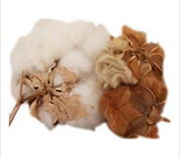 Diamond/ Broken Twill (diagonally woven fabric) Diamond/ Broken Twill (diagonally woven fabric)- Cotton Satin (closely woven cotton with lustrous face)
- Cotton Plain (closely woven cotton with plain faces)
- Corduroy (durable cotton piled fabric with vertical ribs)
- Canvas (fancy woven fabric)
- Poplin (corded woven and worsted)
- Cambric (fine thin white cotton or linen fabric)
- Cotton Yarn Dyed (diagonally woven fabric)
- Voile (soft fine sheer fabric)
- Organic Khadi (homespun cotton cloth)
Organic Khadi
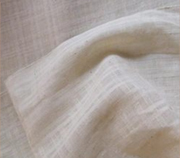
Organic khadi is totally environment friendly. Organic Khadi is made toxin-free, reducing the amount of toxic chemicals, we ingest and release into earth. It is claimed that the organic Khadi clothes do have medicinal values, as they help the body in fighting diseases like skin infection, high blood pressure or hypertension of worth regularly.
Natural Fibers
We use 100% Natural Fibers for our Garments
| Bamboo |
Bamboo fabric is a natural textile made from the pulp of the bamboo grass. Bamboo fabric has been growing in popularity because it has many unique properties and is more sustainable than most textile fibers. |
| Flax |
flax fabric is made from 100% natural flax fibres. This fibre is one of the oldest used in textiles for the home & clothing. |
| Hemp |
Hemp fabric is made from the stems and dried flowers and leaves of the Cannabis Sativa plant. Hemp fabric is like linen in both hand and appearance. |
| Linen |
Linen is a textile made from the fibers of the flax plant, Linum usitatissimum. It is valued for its exceptional coolness and freshness in hot weather. |
| Khadi |
Khadi is Indian handspun and hand-woven cloth. It is a versatile fabric, cool in the summer and warm in the winter. |
| Soyabean |
Fabric made from soyabeans is also termed as ‘’soy fabric’’.soy fabrics are made from soybean hulls.It is most friendliest and sustainable textile. |
| Banana |
Banan fabric is made of the stem of banana tree.It is soft,textured and is more sustainable than cotton. |
| Pineapple |
Pineapple fabric is made of leaves of the pineapple plant. Pineapple fabric is lightweight, easy to care for and has an elegant appearance similar to linen |
| Ramie |
Ramie (Boehmeria nivea) is a flowering plant in the nettle family Urticaceae. It is a bast fibre, and the part used is the bark (phloem) of the vegetative stalks. Ramie is one of the strongest natural fibers. It exhibits even greater strength when wet. |
| Wool |
Wool is the hair of some mammals. Wool can be spun or made into yarn. The yarn is used to weave fabric or material. |
|
SILK
The Queen of Textiles, spells luxury, elegance, class and comfort. Scientifically speaking, silk is made of proteins secreted in the fluid state by a caterpillar, popularly known as 'silkworm'. These silkworms feed on the selected food plants and spin cocoons as a 'protective shell' to perpetuate the life. Man interferes this life cycle at the cocoon stage to obtain the silk.
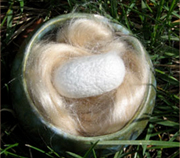
There are Three major types of Natural silk (i.e. Mulberry,Tassar, Eri,Muga) of commercial importance, obtained from different species of silkworms, which in turn feed on a number of food plants. Mulberry silk comes from the silkworm, Bombyx mori that solely feeds on the leaves of mulberry plant. These silkworms are completely domesticated and reared indoors.
We use 100% Natural Silk
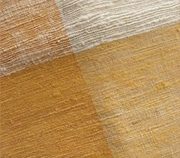 Eri: Also known as Endi or Errandi, Eri is a multivoltine silk spun from open-ended cocoons, unlike other varieties of silk. Eri silk is the product of the domesticated silkworm, Philosamia ricini that feeds mainly on castor leaves. Eri: Also known as Endi or Errandi, Eri is a multivoltine silk spun from open-ended cocoons, unlike other varieties of silk. Eri silk is the product of the domesticated silkworm, Philosamia ricini that feeds mainly on castor leaves. |
|
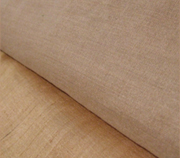 Muga: This golden yellow color silk is prerogative of India and the pride of Assam state. It is obtained from semi-domesticated multivoltine silkworm, Antheraea assamensis. These silkworms feed on thearomatic leaves of Som and Soalu plants and are reared on trees similar to that of tasar. Muga: This golden yellow color silk is prerogative of India and the pride of Assam state. It is obtained from semi-domesticated multivoltine silkworm, Antheraea assamensis. These silkworms feed on thearomatic leaves of Som and Soalu plants and are reared on trees similar to that of tasar. |
We also use variety of 100 % Natural Silk
|
- Ghichha Silk
- Nassi Silk
- Eri-Muga Than
- Mulberry Silk
- Kora Silk
|
|
- Desi Tassar Silk
- Bafta Silk
- Kosa Silk
- Tassar-Muga Silk
|
|
| |
|
|
 |
|


